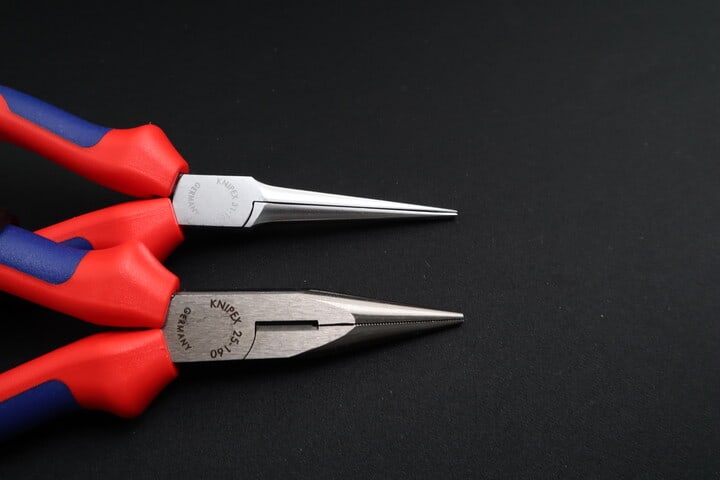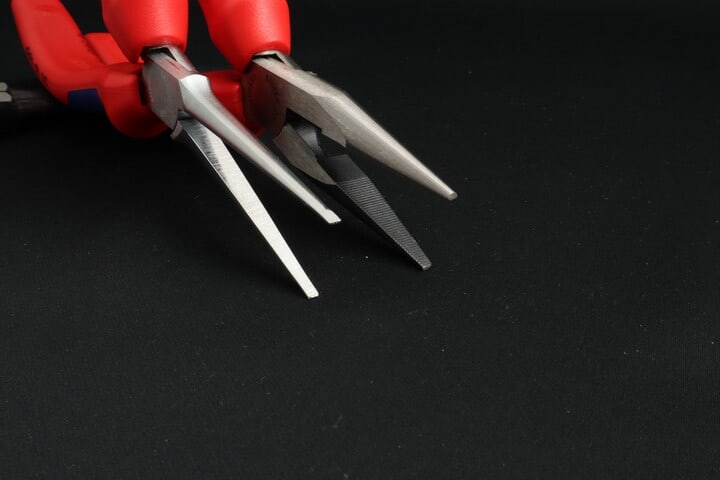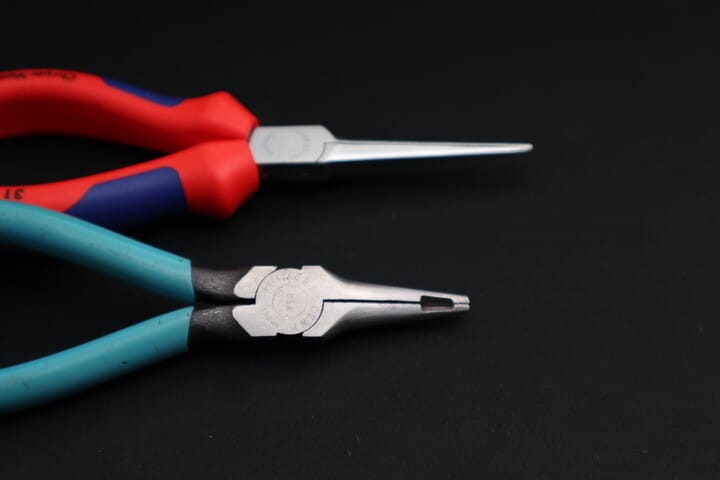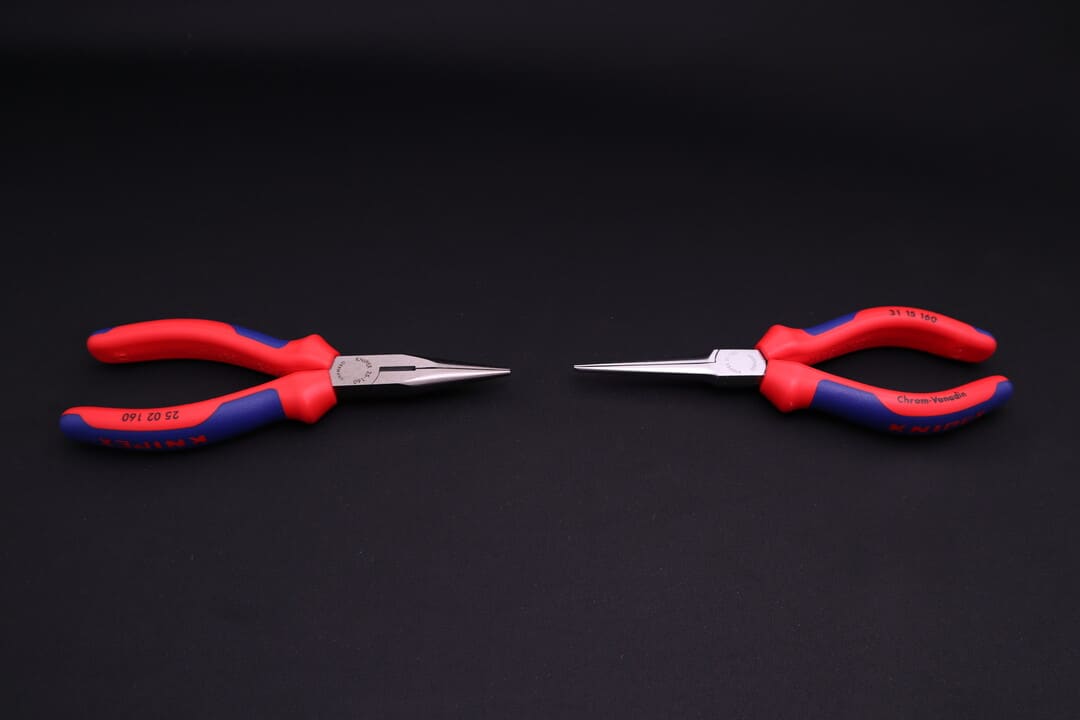If you have been working in the crafts, you are likely to have heard the terms long nose pliers and needle nose pliers. You also probably have at least a rough idea what kind of pliers these refer to.
But you may have wondered are long nose and needle nose pliers just the same, and the terms synonymous? I was wondering the same, and decided to do some research. In this article, I will go through what I found out.
The answer, in a condensed form, is that long nose and needle nose pliers are quite similar tools and the terms are sometimes used interchangably. However, the two pliers types are not actually the same, but differ in many respects, such as nose profile, available sizes and gripping force capacity. In summary, long nose pliers are somewhat larger, have thicker and stronger knurled jaws, and are suited for heavier general use in mechanics and electronics. Needle nose pliers, on the other hand, are smaller, have thinner and weaker smooth jaws, and are suited for fine mechanics, jewelry and fine electronics work.
Below, we are going to take a deeper look into the similarities and differences between long nose and needle nose pliers. If you trying to decide which ones are best for your work, the information should be helpful to you.
Similarities
Before delving into the differences, it is good to recap what the two plier types share. Long nose and needle nose pliers are similar in that both have
- long, relatively slender, tapering jaws
- semi-circular jaw cross section with flat gripping surface and a round back
- very good reach compared to pliers in general
- low-to-medium gripping force compared to pliers in general
- versions with straight and bent jaws
Given the level of similarity, it is not surprising that the two terms are often mixed.
Differences
Let us go through the differences between long nose and needle nose pliers one by one:
1 Nose profile

The jaws of long nose and needle nose pliers are similar in that both are long, slender and tapering, and have a half-circle cross section.
However, in a closer comparison the nose profiles of the two pliers are quite different:
Long nose pliers have a roughly linear taper in their jaws. This means that the jaw cross section loses height and width at a constant rate from root to tip.
Needle nose pliers jaws, by contrast, have a varying taper: they taper very sharply right after the joint, and much slower after that.
The different nose profile is a defining characteristic of these pliers. It also allows you to quickly tell the types apart: long nose pliers jaws appear conical due to the linear taper, whereas the jaws of needle nose pliers look more slender and pointed.
In addition to the different appearance, the jaw profiles have important practical consequences, discussed in the next sections.
2 Gripping force
Due to the different tapers, long nose and needle nose pliers have different gripping force capacities.
Long nose pliers jaws are thicker and thus stronger and stiffer. They allow you to grip objects with a higher force throughout the jaw length, and make long nose pliers suited for heavier work.
Needle nose pliers jaws are more slender, more flexible and weaker. This means that you will be able to take only a gentle hold of objects with the pliers tip, and makes needle nose pliers suited for light work only.
3 Reach and precision
The different jaw tapers of long nose and needle nose pliers also affect the reach and finesse of the pliers jaws.
Thanks to their slenderness, the needle nose pliers jaws take less space than the jaws of long nose pliers, and have better reach and precision than long nose pliers. This allows the needle nose pliers to reach into tighter spots, make sharper bends and smaller loops into wire, as well as grip smaller details than long nose pliers.
Because of the different force capacity and agility, long nose and needle nose pliers are best suited for different work: long nose pliers are better when both good reach and strong grip are needed, and needle nose pliers when lower forces are enough but precision required.
4 Gripping surfaces

Long nose and needle nose pliers often differ in the texture of the jaws’ gripping surfaces.
Like with many other gripping pliers, the jaws of long nose pliers are usually serrated or knurled, i.e. they have a tooth pattern on them. The serration greatly improves the traction that you can get with the jaws, and is important when you are pulling, bending or twisting something. However, it also has the downside of leaving marks on most of the workpieces that you grip.
Needle nose pliers, by contrast, usually come with perfectly smooth gripping surfaces. While the smooth surfaces provide substantially less traction than serrated grips, they do not mark or scratch the workpiece. This is often important when working with delicate objects in fine mechanics or jewelry.
5 Cutting jaws
Long nose pliers are often equipped with cutting jaws which allow you to cut wire. The cutters are usually positioned right next to the joint for optimal leverage.
Needle nose pliers, on the other hand, do not typically have cutting jaws. While you miss the added cutting functionality, the freed up space allows all of the nose length to be used for gripping. For the same overall length, needle nose pliers are therefore able to offer longer effective gripping jaws than long nose pliers.
6 Sizes available
Long nose and needle nose pliers differ in the size ranges they are available in:
Long nose pliers are generally available in overall lengths of 6’’ to 8’’, and are on average longer than needle nose pliers, which come between 5’’…6’’ in overall length.
The difference of 2” in maximum length may be critical in some high-reach use cases, and makes long nose pliers better suited for gripping objects very deep in equipment, for example.
7 Price and availability
Long nose pliers are a more common and high-volume pliers type than needle nose pliers.
Because of the higher sales volumes, long nose pliers are stocked in higher numbers and more configurations than needle nose pliers.
For the same reason, long nose pliers are also on average slightly cheaper than needle nose pliers of the same size.
Summary of differences
The differences between long nose and needle nose pliers listed above and summarized in the table below.
| Long nose | Needle nose | |
|---|---|---|
| jaw profile | linear taper | exponential taper |
| gripping force | medium | low |
| precision | semi-fine | fine |
| gripping surface | knurled | smooth |
| cutting jaws | yes | none (typ.) |
| sizes available | 6”…8” | 5”…6” |
| availability | excellent | good |
| price | lower | higher |
Exceptions
It should be noted that the distinction between long nose and needle nose pliers is not always totally clear cut.
One reason for this, already alluded to above, is that the terms are used interchangeably, mixed, or combined by many users, retailers and manufacturers.
An another reason is that some pliers models exist that actually sit between the conventional types as described above. For example,
- some long nose pliers have smooth, not serrated, jaws;
- some long nose pliers lack cutting jaws, and some needle nose pliers have them;
- finally, some pliers models have a jaw taper somewhere between the linear of long nose and the steep “exponential” of needle nose pliers

Conclusion
After examining the similarities and differences, we can now conclude by addressing the important question: which of the two pliers types is better for different uses?
When long nose pliers are better?
Long nose pliers are better than needle nose pliers in work where good reach and grip are both needed. They are thus more suited to general mechanical and electronics work.
In fact, long nose pliers are probably among the top three most popular pliers types of all.
When needle nose pliers are better?
Needle nose pliers are better than long nose pliers in very fine or detailed work. If you need to reach very tight spots, grip small details, bend light-gauge wire to small loops, or grip soft metals without leaving marks, needle nose pliers are your choice.
These properties make needle nose pliers best suited for work in fine mechanics, jewelry and in detailed electronics. They are more of a speciality type and not as general-purpose as long nose pliers; if you are not quite sure which to buy, get a pair of long nose pliers first.
